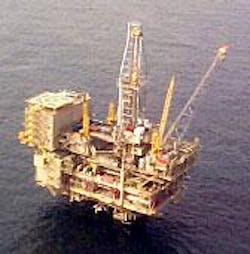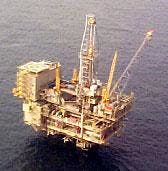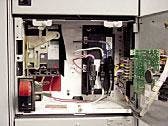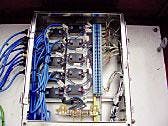Improvements in surge protection eliminated rig downtime off W. Africa
Improvements in electric surge protection eliminated downtime and equipment failures from lightning storms on the Jade platform in Zafiro oil field off Equatorial Guinea. Jade is the largest fixed production-drilling platform off West Africa (Fig. 1). A unit of ExxonMobil Corp. operates the field.
In 2000–01, the platform suffered instances of equipment downtime on platform controls, drives, and other equipment during or within 1-2 weeks after lightning storms. This problem is common for drilling rigs and oil platforms and is usually accepted as normal maintenance because these platforms sit 100 ft or more above the water and are, therefore, the best lightning rods for miles around. Although it is expected that lightning may hit the rig, one particular storm devastated practically every major drilling electrical system on the rig. On that day after the boom, the platform had lights but several electronic controls and drives were down. The repair parts alone cost more than $60,000. Other storms had cost $40,000-56,000 for repair parts.
These costs do not include other downtime expenses and lost production.
null
Solution
The drilling platform needed improved protection for the following systems:
- Power generation units.
- Variable-speed motor drives.
- Power-factor correction controls.
- Programmable logic controllers (PLCs).
- Computers.
- Telemetry equipment.
- Communications equipment.
- Various industrial electronic controls.
The total platform and equipment protection solution involved grounding, ground bonding, secondary surge arrestors (SSAs), and transient-voltage surge suppressors (TVSSs).
The rig already had surge suppressors installed on the circuit breaker panels, but these had an inadequate design and were replaced by faster, tighter clamping, filtering TVSSs at the main power transformers, motor control center (MCC) panels, and at the load side of PLC or electronic control transformers for AC power protection.
Power-line protection
Three basic categories have evolved over the years for power-line protection:
1. Secondary surge arrester (SSA).
2. Surge protection device (SPD).
3. Transient-voltage surge suppressor (TVSS).
Also there is a gray area between each of these categories when comparing the specifications of one device with another. SSA devices are tested to meet cUL, whereas SPD and TVSS are both tested to UL-1449, IEEE-587, and ANSI/IEEE C62.41 standards.
The intent of SSA devices is to protect electrical gears by providing large surge currents a path to ground. Tests also require SSA survival through multiple surges to provide future surge arresting capability. SSAs function from line to ground.
By comparison, SPD and TVSS may work line to ground and/or line to line. These devices clamp tighter and may sacrifice themselves to protect the down-line equipment. Their intent is to protect more sensitive electronic equipment with faster response time and tighter clamping voltages, but the devices do not have to handle such large surge current as SSAs.
Some history may clarify the proper application of these devices.
Between 1940 and 1970, lightning arresters and surge arresters consisted of fixed-width arc gaps and then gas tubes to allow lightning energies to jump from antennas or from long power lines to ground, across a known flashover point, rather than through motors, transformers, or radio equipment.
In the 1970s, General Electric Co. invented the metal oxide varistor (MOV) that allowed much more accurate and consistent control of over-voltages. Placement of MOVs in series with a gas tube provided more accurate flash-over voltage and allowed the arc to extinguish after voltages were brought back within limits.
The 1983 IEEE-587 study, with its surge suppressor test wave-shapes, started an entirely new industry and device category called SPD or TVSS. These devices were geared more toward protecting secondary voltage equipment, such as computers and electronics, with faster response time and tighter voltage clamping levels.
SPD devices are made with simple MOVs, whereas TVSS devices have more complex circuits, such as the TVSS circuit patents by EFI Electronics Corp. in 1986 that combined:
- MOVs (high energy).
- Avalanche diodes (high speed).
- Metalized non-polarized capacitors (for ring dampening and noise attenuation).
- Inductor reactors.
- Mechanical or thermal fusing for fail-safe fault mode handling, etc.
More than 150 companies manufacture or private-label MOV components, SSA, SPD, and TVSS devices.
Comparative voltage clamping levels for SSA, SPD, and TVSS on a 120-v AC power line are as follows:
- SSA devices typically provide 500–1,500 v clamping.
- SPD devices typically provide 240–500 v clamping.
- TVSS devices typically provide 180–300 v clamping and some complex sine-wave tracking TVSS devices provide 15–30 v clamp tracking through the full 360° of the power sine wave.
Each, however, has its place and appropriate application.
Jade installation
In the case of the Jade platform, SPD devices were already in place on most 480-v AC and 120/208-v panels. Yet problems persisted. These SPDs were replaced with more complex TVSS devices along with the following mentioned derrick grounding, ground bonding, control line TVSS, etc.
null
Fig. 2 shows the retrofitted Buss A starter can with a TVSS module, and Fig. 3 shows the new TVSS modules in the drawworks side fingerboard solenoid J-box.
Pure avalanche diode suppressors, free of internal impedance and capacitance, were employed on data lines, input/output (I/O), and analog control lines. Three-stage suppressors were employed on longer telemetry lines to handle higher energy surges and achieve tighter clamping of transient voltages.
Cylix Corp., Stormin Protection Products Inc., and EFI Electronics Corp. supplied the TVSS devices needed for the various specific panel, line, and equipment.
In most industrial environments, one can expect to see immediate benefits of increased equipment reliability and accuracy after installation of protection against lightning storms. When the installation is done properly, it is common to see a 92% reduction of all electronic malfunctions, failures, and downtime.
Another change on the Jade platform was installation of new TVSS modules to the drawworks side fingerboard solenoid J-box (Fig. 3).
Equipment becomes reliable with nearly 100% uptime because, according to the IEEE-587 study, 65% of the transients and surges that affect equipment are not genereated by lightning storms but are generated within the facility by switching of inductive loads (equipment switching on and off, in and out, and cycling of equipment loads).
Facility equipment generates more transient voltage spikes and power surges than does lightning. But lightning can produce some of the more spectacular and catastrophic surges.
Facility transformers and power line filters serve a function similar to the shock absorbers on a car: They average or smooth noise and bumps but offer little or no help against sharp voltage transients and current surges that one can liken to the shock of hitting a large pothole.
Jade already had in place the customary derrick lightning rod and ground cable but the drilling-control room still experienced multiple problems, including lightning flash-over and electronic equipment damage. This traditional lightning rod and ground cable also left the derrick skid's vulnerable to flashover weld spots.
These derrick problems were corrected by installating a much more efficient and less expensive ground bonding method that drew on more recent lightning protection studies and methods. It had the objectives of:
- Employee safety.
- Electronic equipment protection.
- Fire prevention.
- Derrick skids and platform protection.
Wolf Lightning Protection of Cleveland, Ga., did the cad-weld and installed the grounding and ground bonding changes prescribed for the derrick and platform.
Within the 2 years since the improvements were made, the platform has experience many storms and lightning, with some direct hits, but has not had any downtime or damage to any protected systems.
The authors
Howard C. Cooper is chief consultant with Amemco, Kaysville, Utah. He previously worked as a maintenance engineer, improving manufacturing systems, and automation equipment uptime for Deere & Co., Signetics, and Baker Hughes EIMCO. Cooper holds a BS in electronic technology from Southern Utah University. ([email protected])
Roger M. Sanford is lead electronics technician on the Jade platform for Helmerich & Payne International Drilling Corp., Tulsa. He has 25 years experience on drilling rig systems maintenance and fabrication. Sanford has an associate degree in maintenance and electronic technology from Oklahoma State Technical University. ([email protected])





